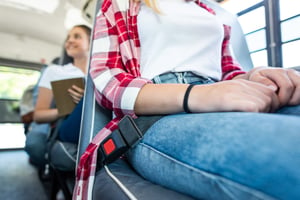School Bus Safety: More Than Just Seat Belts
published on May 21, 2019 by Sonia Mastros
 Many school districts looking to improve their school bus safety are starting to turn to seat belts as one potential answer. However, the debate over school bus seat belts is surprisingly complicated. Plus, in any case, retrofitting an entire bus fleet with belts on every seat is a very expensive proposition.
Many school districts looking to improve their school bus safety are starting to turn to seat belts as one potential answer. However, the debate over school bus seat belts is surprisingly complicated. Plus, in any case, retrofitting an entire bus fleet with belts on every seat is a very expensive proposition.
Without wading into the question of whether school bus belts will actually save lives, we've got some suggestions for more cost-effective alternatives to improve school bus safety.
Four Cost-Effective Ways to Improve Your School Bus Safety Setup
1. Add More Lights to the Rear of the Bus
There is plenty of evidence that simply adding more and brighter lights to school buses can significantly reduce illegal stop-arm passing. At a cost of only a few hundred dollars per bus (if that), this is something that would be easy to budget for while providing an overnight improvement in safety.
Plus, it's a lot less controversial than the other alternative: stop arm cameras and fines.
2. Reduce the Distance Children Have to Walk to the Bus
One of the most dangerous times for a child riding the bus is just before or after their bus ride, when they're walking between the bus stop and home. Changing your routes to minimize this distance will significantly improve safety, but should only have a small impact on operations. Bus route calculation software can make this sort of optimization much easier.
3. Route Around Dangerous Areas
When putting bus routes together, it's easy to focus solely on the logistics of moving students between points A and B. However, not all roads in your district are created equal. Some are going to see higher traffic, and higher chances of accidents. Others go through neighborhoods where students simply should not be.
Routing around these danger zones improves safety at little or no cost.
4. Add GPS Tracking
Yes, adding GPS tracking systems to your buses would be more expensive than some other safety propositions. But, GPS systems can actually bring you a return on your investment, on top of the safety improvements. By being able to track your buses on the road from minute to minute, you'll have much better oversight of your buses and rapid warning if something has gone wrong. Then, in the long term, you'll build up a database of information that makes it easier to optimize aspects of your fleet, like mileage and fuel usage, to create cost-savings.
GPS units can pay for themselves via optimization within a couple years, and then keep bringing benefits for many more years to come.
How does your district look to improve safety on their bus rides? Let's share tips in the comments below!



